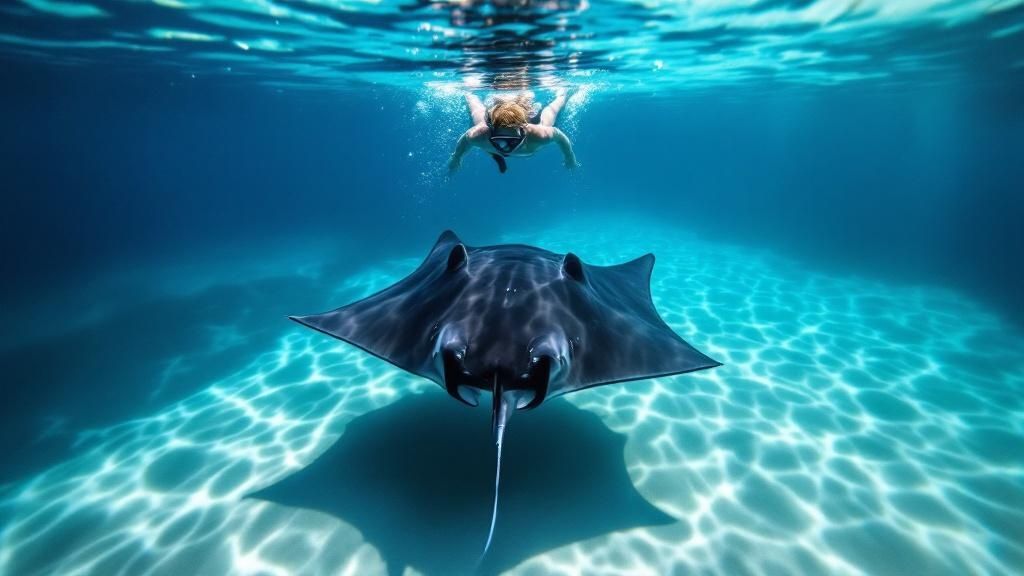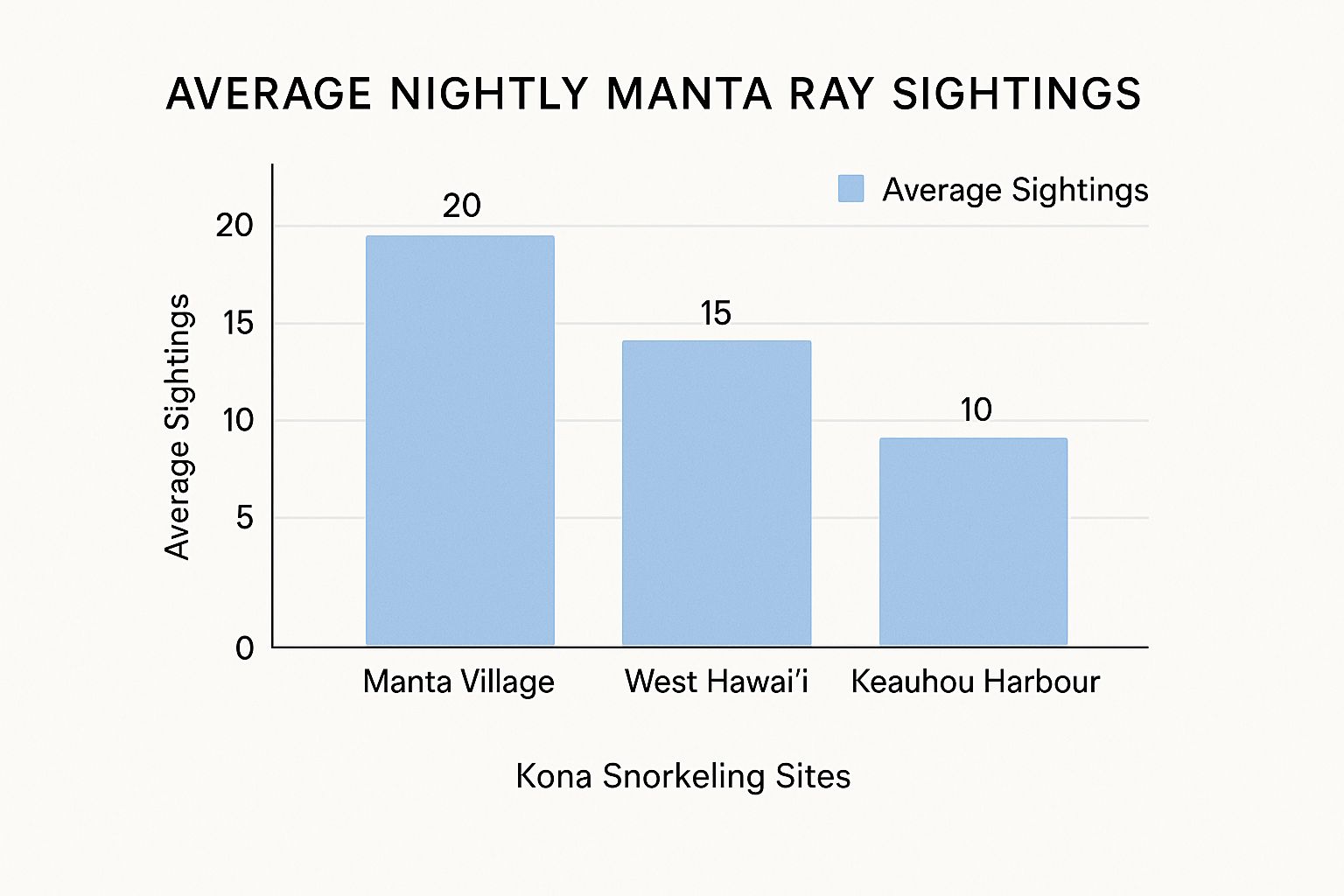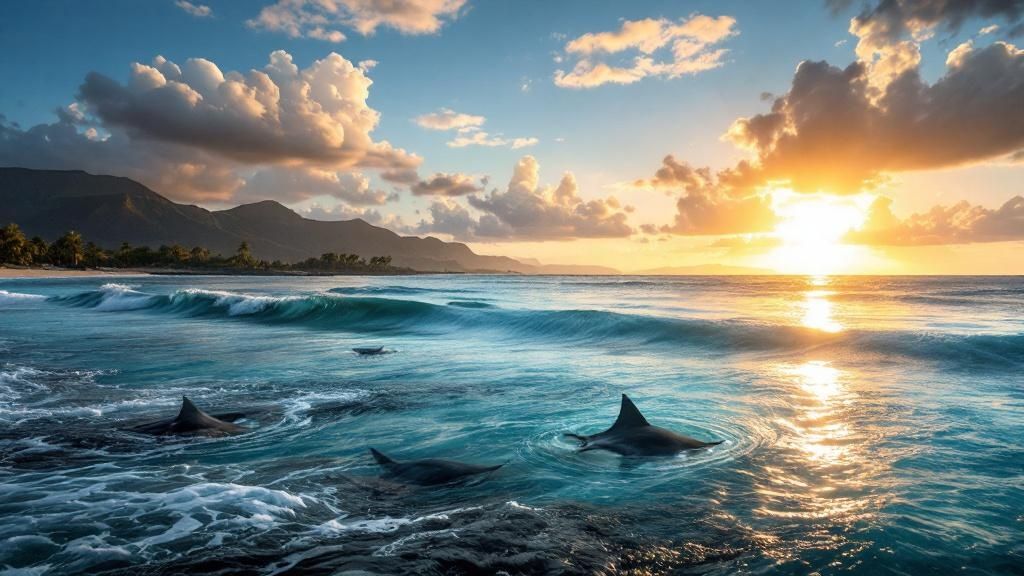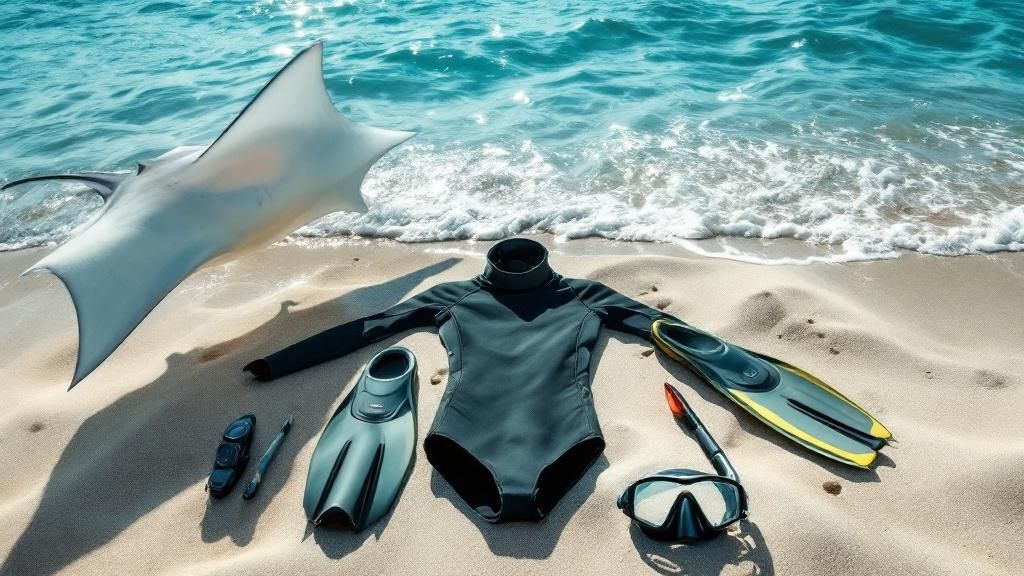Manta Ray Snorkel Kona: Night Adventure Guide
- Byron
- Jun 15
- 12 min read
Why Kona's Manta Ray Night Snorkeling Is Worth Every Penny

Let me tell you, manta ray snorkeling in Kona isn't just another item to check off your bucket list. It's a truly awe-inspiring experience. I've chatted with tons of people who've done it, and everyone says the same thing: it's mind-blowing. Picture this: you're floating in the dark ocean, and suddenly a 12-foot manta ray glides effortlessly beneath you. It's a moment you won't soon forget.
Kona is special, not just for the mantas themselves, but for the perfect storm of conditions that bring them here. The currents, plankton, and underwater landscape create an ideal feeding ground for these gentle giants. The warm Hawaiian waters are comfortable year-round, visibility is fantastic, and predictable plankton blooms draw the mantas in like clockwork.
This kind of experience offers a real connection with wildlife. It's both humbling and exhilarating. You’re witnessing these creatures in their natural habitat, feeding and interacting as they would without any human intervention. It's a far cry from seeing them in an aquarium.
Why Kona is the Spot for Manta Rays
Kona's manta ray night snorkeling is wildly popular, drawing about 80,000 people each year. Why? Because the chances of actually seeing manta rays are incredibly high – between 80% and 90%. That means roughly 8 or 9 out of 10 snorkelers get to encounter these majestic creatures. Intrigued by the numbers? Discover more insights.
Beyond the initial awe of seeing these creatures up close, you gain a deeper understanding of the ocean’s delicate ecosystem. Watching how the mantas feed on plankton, for example, really highlights their role in the food chain and underscores the importance of protecting these habitats.
More Than Just a Tourist Activity
This experience often sparks a desire to learn more and even contribute to manta ray conservation. Want to dive deeper? Check out The Ultimate Hawaii Night Adventure. Seeing it firsthand creates a sense of responsibility for protecting these amazing animals and their environment. It's something that stays with you long after you’re back on dry land.
In today's busy world, this adventure offers something rare: a moment of pure connection with nature. This connection leaves a lasting impact and often inspires a deeper appreciation for the ocean and all its inhabitants. It's a reminder of the beauty and wonder that lies just beneath the surface, waiting to be explored. This isn't just another tourist activity; it's a chance to connect with something bigger than yourself and gain a new respect for the natural world.
Choosing Your Manta Ray Tour Like A Kona Local

This chart shows the average manta ray sightings at three Kona spots: Manta Village, West Hawaii, and Keauhou Harbour. Manta Village averages around 20 sightings, making it a popular choice for manta ray night snorkeling. Keep in mind, though, that popularity sometimes translates to crowds.
Picking the right manta ray tour can make or break your experience. I've seen firsthand how a poorly chosen tour can turn a magical evening into a frustrating mess. So, here's the inside scoop on what really matters when booking a manta ray tour in Kona.
What to Look For in a Quality Tour
A good tour operator prioritizes your experience. They invest in high-quality equipment, hire experienced guides who know manta ray behavior, and use comfortable boats designed for night snorkeling. Check online reviews, too. Consistent complaints about rushed tours or overcrowded boats are a huge red flag. Also, be wary of prices that seem too good to be true – they usually are. Don't fall for flashy marketing; focus on what the tour actually offers. For more tips on evaluating online services, check out the Pingenerator Blog.
Questions to Ask Before You Book
Before booking, ask about bad weather backup plans, the guide-to-guest ratio, and how long the company has been operating. These details might seem small, but they can greatly impact your experience. The price difference between a $90 budget tour and a $150 premium one often reflects the quality of your time in the water. Trust me, it’s worth checking out resources like this one: Manta Ray Night Snorkeling Experience: Ocean Magic Up Close. Remember, it’s not just about seeing manta rays; it's about having an unforgettable experience. Spending a little extra can make all the difference.
Why Group Size Matters
Smaller groups mean better manta ray interactions. In large groups, the mantas might feel threatened and swim away. A smaller, calmer environment encourages them to approach closer and behave naturally. The sweet spot for group size is 12-15 people. This creates a more intimate and rewarding experience for everyone.
To help you compare different tour options, I've put together this handy table:
Kona Manta Ray Tour Comparison Guide Compare key features of different tour types including group sizes, duration, equipment quality, and booking considerations
Tour Type | Group Size | Duration | Equipment Included | Price Range | Best For |
|---|---|---|---|---|---|
Small Group Premium | 10-15 | 2-3 hours | High-quality mask, snorkel, fins, wetsuit | $150-$200 | Close encounters, personalized experience |
Standard Group | 20-30 | 1.5-2 hours | Basic mask, snorkel, fins, wetsuit | $100-$150 | Budget-conscious travelers |
Private Charter | Customizable | Customizable | Often includes premium equipment | $500+ | Families, small groups seeking exclusivity |
This table summarizes key differences between tour types, highlighting the trade-offs between group size, price, and the overall experience. As you can see, small group tours often offer a more intimate experience, while private charters provide maximum flexibility.
Mastering Kona's Famous Manta Ray Hotspots

While your tour guide will steer you right for the best manta ray action, knowing a little about Kona’s famous spots makes the experience even richer. Think of it like this: you can appreciate a painting, sure, but understanding the artist’s methods and inspiration adds a whole other dimension. Knowing what makes Manta Village and Garden Eel Cove tick turns your snorkel trip into a true exploration of Kona's marine ecosystem.
Manta Village, for instance, is known for reliable manta sightings, but it can get crowded with tour boats. This creates a different vibe compared to the potentially quieter encounters at Garden Eel Cove, which really shines when conditions are perfect. Each spot has its own personality, and understanding this helps you appreciate why your captain chooses a particular location on a given night. Curious to learn more? Check out A complete guide to magical encounters.
The Science Behind the Spots
That sandy bottom at these locations? It's no accident. The sand is key to attracting the mantas. It reflects the underwater lights, creating bright spots teeming with plankton – the mantas' main food source. Kona's night snorkeling setting offers a captivating way to see wildlife, and these hotspots like Manta Village and Garden Eel Cove each add their unique flavor to the experience. For more insights into these unforgettable encounters, read this. This plankton-rich, brightly lit environment becomes an irresistible dinner bell for the manta rays.
Nature's Influence
Beyond the locations themselves, other factors impact the manta ray viewing. Weather, currents, moon phases, and even the seasonal plankton blooms all have a say. These natural elements determine which site will offer the best viewing on any given night.
Understanding this adds another layer of appreciation to what might seem like a simple wildlife encounter. It also helps you set realistic expectations and gives you some informed questions to ask your guide, making the whole trip more engaging. By considering these variables, you'll be ready to soak in the magic, no matter where you end up.
Preparing For Your Night Snorkel Adventure
Let me tell you, the difference between a decent manta ray snorkel and one that absolutely blows you away often boils down to preparation. Here’s the real deal, the insider tips most tour operators won’t share.
Before You Set Sail
Think about what you eat before you go. A light and satisfying meal about two hours beforehand is perfect. Steer clear of dairy and heavy foods – they can make seasickness much worse. Trust me, you don't want that.
Also, let’s talk about nighttime in the water. Even strong swimmers who are totally fine snorkeling during the day can get a little uneasy in the dark. It's a completely different ballgame. Try this: practice floating calmly in a pool with your eyes closed. It sounds simple, but this really helps you get used to the sensation and boosts your confidence for the actual snorkel.
What to Wear and Bring
Wear a swimsuit that’s comfortable and stays put. You’ll be floating pretty still for a while, so you don’t want anything that’ll shift around or ride up. A light jacket for the boat ride is a good idea too. It can get chilly on the water, especially after the sun goes down.
Even if you don't usually get seasick, consider taking some motion sickness medication. The excitement combined with the darkness can sometimes get to people. Better safe than sorry!
If you’re bringing an underwater camera, test it out thoroughly beforehand, particularly in low light. Knowing your camera's quirks means you won't be messing with settings while the mantas are putting on their show. For more planning tips, check out this guide: Manta Ray Snorkel Kona: Complete Night Adventure Guide.
Managing Expectations
One last thing: remember that wild animals do their own thing. The most magical moments often happen when you're relaxed and go with the flow. Embrace the unexpected! Don't get so focused on getting the perfect photo or video that you miss out on just being there in the moment. Sharing the ocean with these gentle giants is an amazing experience in itself.
Quick Checklist for Success
Light, satisfying meal 2 hours before departure
Practice floating calmly in a pool with closed eyes
Comfortable, secure swimsuit
Light jacket for the boat ride
Motion sickness medication (optional but recommended)
Tested underwater camera (if you’re bringing one)
Most importantly: a relaxed and patient mindset!
Making The Most Of Your Time In The Water

So, you’re about to slip into the inky black water for a face-to-face with some of the ocean’s most graceful giants. Trust me, it's an experience you won't soon forget. But how do you make the most of every second? It really boils down to understanding how your presence affects these magnificent creatures. Think of it as a delicate dance between you and the mantas.
Remember this golden rule: less movement means better viewing. Mantas are naturally curious, but they can be easily spooked. Splashing about wildly is a surefire way to send them gliding off into the darkness. These aren't small fish; we're talking wingspans of 12 feet or more! Seeing them up close in calm, clear water is truly breathtaking. Experienced guides know the best spots and conditions for maximizing your chances of an unforgettable encounter. Want to learn more about these incredible creatures?
Positioning for the Perfect View
Now, you might think the best spot is right in the center of the action, directly under the lights. Think again! I've found that positioning yourself just outside the main light cone often gives you the best views. Mantas frequently cruise through this outer zone between feeding passes, offering an amazing perspective of their graceful movements as they approach. It's like having VIP seats to the most elegant ballet in nature.
Staying Calm Amidst the Excitement
Before you even hit the water, set yourself up for success. A good night’s sleep and an energizing morning routine can make a world of difference. Once you’re in the water, controlled breathing is key. It’s perfectly natural to feel a rush of adrenaline when a massive ray glides just inches below you. But trust me, sudden movements can scare them away. Focus on deep, steady breaths to stay calm and present.
Understanding Manta Body Language
Learning to read manta body language adds another level to the experience. Smooth, predictable movements mean they're comfortable. Rapid changes in direction, however, signal they might be feeling a bit pressured. Respect their space, and they'll reward you with their presence. And no matter how tempting, keep your hands to yourself! Resist the urge to reach out and touch them.
Dealing with Sensory Overload
The combination of darkness and excitement can sometimes be a bit much. If you start to feel overwhelmed, concentrate on your breathing. Your guide is always nearby and ready to assist. Also, keep in mind that manta activity often picks up as the evening goes on. So even if things seem quiet at first, patience often pays off with some truly spectacular close encounters later on.
Here's a handy guide I've put together to help you make the most of your manta ray encounter:
Manta Ray Encounter Guidelines: Essential do's and don'ts for respectful manta ray interactions and optimal viewing positions
Situation | Do This | Avoid This | Why It Matters |
|---|---|---|---|
In the water | Move slowly and deliberately | Splashing, sudden movements | Mantas are easily startled by erratic behavior |
Positioning | Stay slightly outside the main light cone | Crowding the center of the action | Mantas often cruise the outer zones between feeding passes |
Manta interaction | Observe from a respectful distance | Touching or chasing the mantas | Respecting their space encourages them to stay longer |
Feeling overwhelmed | Focus on controlled breathing, alert your guide | Panicking, making abrupt movements | Staying calm ensures both your safety and the manta's comfort |
Keeping these guidelines in mind can significantly enhance your experience and contribute to a positive interaction with these gentle giants. Remember, we are visitors in their world, and respectful observation is key to a truly memorable encounter.
Troubleshooting Common Night Snorkel Challenges
Let's be real, even the most meticulously planned manta ray night snorkel in Kona can hit a snag. But don't worry, knowing how to handle the usual hiccups can save the day (or night!) and keep your experience amazing.
Weather Woes and Itinerary Adjustments
Mother Nature has her own schedule, and in Kona, that means weather can be unpredictable. It’s the biggest reason tours get rescheduled. Reputable operators will always put safety first, so build some wiggle room into your Hawaii itinerary. Trust me, you don't want a non-refundable luau booked right after your snorkel tour only to have the weather turn and miss both.
Mask Mishaps and Fog Frustrations
Foggy masks? We’ve all been there. It's especially annoying when you're trying to see mantas! A good anti-fog solution is key (I swear by Spit Anti-Fog), but surprisingly, so is not over-tightening your mask strap. Snug is good, too tight creates more fog. Go figure.
Seasickness Strategies for Smooth Sailing
Even seasoned ocean-goers can get a little green around the gills. The mix of excitement, darkness, and the gentle rocking of the boat can be a recipe for seasickness. Focusing on the horizon helps (if you can), and so does staying hydrated. I always pack ginger candies and acupressure wristbands – they’re lifesavers.
Equipment Essentials and Quick Fixes
Sometimes gear malfunctions, or just doesn’t fit right. Don't suffer in silence! The crew is there to help. They've seen it all and are happy to swap out anything uncomfortable or broken. For more planning tips, check out this guide. It covers everything from choosing a tour to what to pack.
Navigating Crowded Waters and Securing Your View
Popular tours can get crowded. Don’t be shy about politely (but firmly) claiming your viewing spot. A simple "Excuse me, I'd love to see too" works wonders. Most people are just excited and not trying to be rude.
Cancellation Policies and Contingency Plans
Before you book anything, understand the cancellation policy. Most good companies offer full refunds or reschedules for weather cancellations. Some budget operators might only offer credits, which isn’t ideal. Knowing this upfront prevents headaches later.
Your Complete Manta Ray Adventure Action Plan
So, you're thinking about a manta ray night snorkel in Kona? Awesome! Let me give you the inside scoop on planning, booking, and making the most of this incredible experience. I’ve done this a few times, and trust me, there are some things you’ll want to know beforehand.
Putting it on your calendar is a smart move – you won’t want to forget this! Exporting individual events as ICS can be super helpful for keeping track. Booking in advance, like a week or more, especially during busy times, is essential. However, Kona weather has a mind of its own. Try to build some wiggle room into your schedule in case you need to reschedule – avoid booking other activities right after your tour.
Budgeting for Your Manta Ray Experience
Think beyond just the tour price. Those guides work hard to make your experience special, so factor in tips. They deserve it! Also, renting an underwater camera is worth considering if you’re serious about capturing those underwater moments. And, check if your tour includes snacks. If not, you'll want to account for food before or after.
Packing Essentials for a Smooth Trip
Reef-safe sunscreen is key for daytime fun, but don't forget a light jacket for the boat ride – those evening breezes can get chilly. Practical footwear is also essential. Trust me, comfortable, non-slip sandals that won’t fly off your feet when you're stepping on and off the boat are a lifesaver.
Setting Realistic Expectations for Your Adventure
Manta ray sightings in Kona are pretty amazing, but remember, it's wildlife. There are no guarantees. Conditions play a big role, too. A calm, clear night is ideal for viewing, but choppy water can make things a bit tougher, impacting visibility and overall enjoyment.
Extending Your Manta Ray Experience Beyond the Snorkel
Want to take your manta ray love to the next level? Check out the Manta Ray Identification Project. It's a fascinating deep dive into these creatures' individual personalities and behaviors. Learning about local conservation efforts adds a whole other dimension to the experience.
Approaching Your Adventure with Respect and Curiosity
Above all, approach your manta ray adventure with respect and a sense of wonder. These are incredible animals, and the best encounters happen when you're present and appreciate the privilege of sharing their space. Don’t touch or chase them – just relax, observe, and soak in the magic of their underwater ballet.
Ready to jump in? Book your unforgettable manta ray night snorkel experience now at Manta Ray Night Snorkel Kona Hawaii Tours.
Comments